by Laura Huenneke, Provost
Last week I spent several days at an external review meeting for the Partnership for Native American Cancer Prevention. My involvement with this complex, long-term project is exciting and important to me for many reasons—but also raises some important questions for our institution.
I really enjoy my activity with the partnership; it’s a great way to use my scientific background, staying engaged with research and its impact on society. We focus on developing research capacity and collaborating with tribal communities both to determine research priorities and to communicate the relevance of research findings to important community partners. Being engaged personally with this large grant-funded project reminds me why teacher-scholars find research universities such meaningful places to work.
|
But the commitment to this project raises other questions. For one, we wrestle with the underlying meaning of NAU’s strategic goal of serving Native Americans. What aspect of that service—mentoring students, collaborating in research, providing technical assistance—is of highest priority? And how do we make good on this commitment? There’s also the seemingly inevitable tension for faculty of balancing teaching with student contact, dedicated research time and communication or outreach efforts.
Another major question for me as a university leader is this: What are the barriers to successful research here at NAU? From bureaucracy in hiring processes, to the challenges of adapting to our new financial system, to the limited experience with certain kinds of projects or funding agencies, we do confront some obstacles. How best do we bring along the next generation of research leaders? What tensions and conflicts do you experience in balancing scholarship, research and creative activity with institutional and student commitments?



